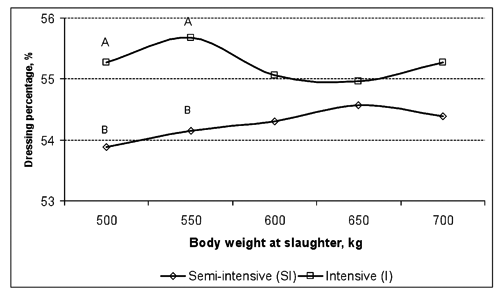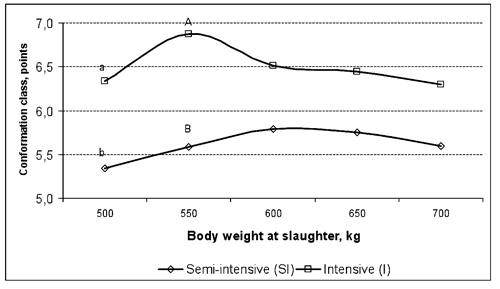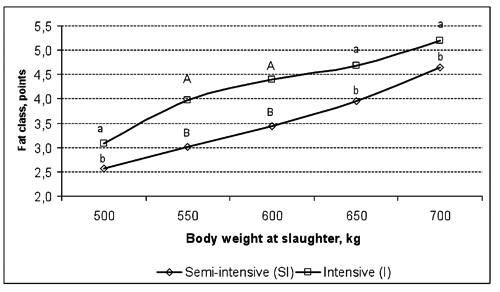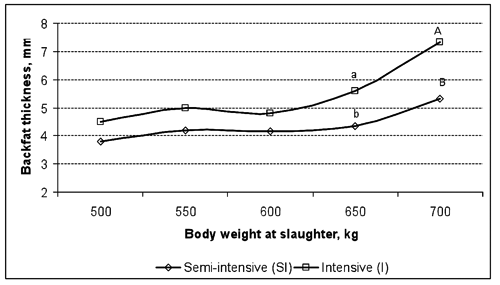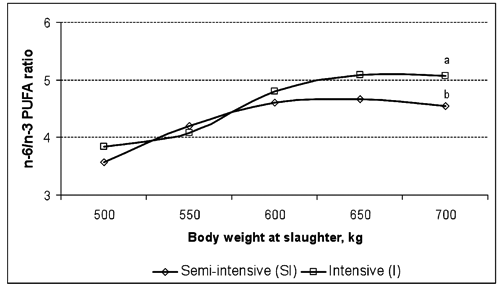Abstract
The objective of this study was to determine the effect of body weight (BW) at slaughter and fattening intensity on carcass fatness and meat fatty acid profile in young Holstein-Friesian bulls. One-hundred bulls fattened on two levels of intensity a semi-intensive (SI) and an intensive (I) were used. Fattening was carried out to BW of 500, 550, 600, 650 and 700 kg. Live ultrasound measurements were performed to determine back fat thickness. Carcass dressing percentage, carcass conformation and fatness, intramuscular fat content of m. longissimus dorsi and fatty acid profile (by gas chromatography) were determined after slaughter. Intensively fattened bulls were characterised by a greater carcass dressing percentage – by 1.17% on average, greater carcass conformation scores, greater external fat thickness and a greater intramuscular fat content than bulls SI fattened. Fat from intensively fattened bulls contained higher levels of polyunsaturated fatty acids (PUFAs) – by 0.96/100 g on average. Semi-intensive fattening contributed to a decrease in the n-6/n-3 PUFA ratio and to a significant increase in the concentrations of C18:2 and C20:4 fatty acids. Regardless of the fattening intensity, the n-6/n-3 ratio was greater in heavier animals. The best results were achieved when young Holstein-Friesian bulls were fattened intensively to BW of 650 kg.
Introduction
In many European countries, beef cattle have a small share in the total cattle population. For this reason, beef production is based mainly on dairy cattle herds of Holstein-Friesians. Selection for dairy traits, carried out for decades, has resulted in the production of bovine carcasses with a low dressing percentage and beef intended mostly for processing. Such meat is cheaper and cannot compete with prime-quality beef in international markets (Seredyn, Citation2006). The most important problems faced by beef producers are too low slaughter weight of cattle and the use of feeding systems not suitable to exploit the fattening ability of animals, with negative consequences in terms of carcass and meat quality (Basarab et al., Citation2007; Sami et al., Citation2004; Węglarz, Citation2010). According to Kirkland et al. (Citation2006), the optimal slaughter weight of intensively- (I) fattened Holstein-Friesian bulls is 550 kg. Therefore, I would indicate than Polish Holstein-Friesian bulls slaughtered at higher BWs are characterised by the best carcass quality (Oprządek et al., Citation2007). It should be noted that Holstein-Friesians are large and late-maturing animals and carcass quality increases with increasing BW (Oprządek et al., Citation2007). Unlike small and early-maturing breeds of cattle, Holstein-Friesians are well suited to long-term I fattening which does not lead to excessive fat deposition or carcass quality deterioration. On the other hand, providing insufficient feed for Holstein-Friesians extends the fattening period and decreases the level of marbling.
The taste and health-promoting properties of beef are determined by both the amount and the quality of fat. Beef owes its specific attributes to the presence of vitamins, phospholipids, sphingomyelin, lysozyme, lactoferrin, and polyunsaturated fatty acids (PUFAs) [conjugated linoleic acid (CLA), arachidonic acid (AA), docosahexaenoic acid (DHA), eicosapentaenoic acid (EPA)]. These biologically active substances are known to have antineoplastic, antioxidant, immune-boosting and antibacterial properties (Decker et al., Citation2000). They also prevent excessive fat deposition (Harris, Citation2001). Conjugated linoleic acid is a potent antioxidant which prevents and inhibits cancer cell growth (Achremowicz and Szary-Sworst, Citation2005). A high n-6 to n-3 ratio of dietary PUFAs is considered a risk factor for some lifestyle diseases. In the modern Western diet, the n-6/n-3 PUFA ratio is 10-15:1, whereas its optimal range is 2-4:1 (Breslow, Citation2006). A natural and cost-effective way to improve the health benefits of beef could be a low-intensity feeding system based on an increased roughage to concentrate ratio in the diet, aimed at reducing the growth rate of animals. Such rations have a more desirable fatty acid profile, in comparison with diets with a high proportion of concentrates, and they positively affect the fatty acid composition of animal tissue (Noci et al., Citation2005). In view of the above, it would be interesting to determine the optimal final BWs of cattle kept in different fattening intensity, in order to enhance the health-promoting properties of beef.
The aim of this study was to determine the effect of BW at slaughter and fattening intensity on carcass fatness and fatty acid profile in young Holstein-Friesian bulls.
Materials and methods
Experimental material
In the experiment 100 young bull Holstein-Friesian bulls were used. The calves were raised in a traditional system to 120 kg BW, and then they were transported to a cattle fattening farm where they were allocated to two groups and were kept in pens (10 animals per pen). Bulls were allocated to the pens randomly. The animals fattened on two levels: semi-intensive (SI) and intansive (I) group, and they were fed ad libitum a total mixed ration (TMR) composed of grass silage and concentrate ( and ). Fattening intensity was defined as the proportion of concentrate energy in relation to the net energy requirements according to the National Institute of Agronomical Research (INRA) at the start of the experiment. It was assumed that in the I fattening at the beginning of the fattening concentrate would satisfy 50% of the energy requirements according to INRA, while in the semi-intensity would satisfy 30%. Changing the concentrate composition at a weight of 300 kg was a correction associated with declining ratio of protein to energy connected with age. Bulls with BW below 300 kg were fed a TMR containing concentrate I (triticale, 71%; rapeseed meal, 25% and premix, 4%), and bulls with BW above 300 kg were fed a TMR containing concentrate II (triticale, 77%; rapeseed meal, 19%; and premix, 4%). Commercial mineral-vitamin premix for fattening cattle (code of product 7619; Cargill Poland Ltd., Warsaw, Poland) consisting of per kg: Ca, 235 g; Na, 79 g; P, 48 g; Mg, 28 g; Fe, 500 g; Mn, 2000 mg; Cu, 375 mg; Zn, 3750 mg; J, 50 mg; Co, 12.5 mg; Se, 12.50 mg; vitamin A, 250,000 IU; vitamin D3, 50,000 IU; vitamin E, 1000 mg; dl-alpha-tocopherol, 909.10 mg. The silage to concentrate ratio, on a DM basis, was 25:75 (SI) and 40:60 (I) (). The ratio was adjusted every four weeks, based on analysis of grass silage for its dry matter (DM).
Fattening was carried out to until 10 bulls in each fattening intensity reached BW of 500, 550, 600, 650 and 700 kg. Animals were weighed weekly. The animals that reached the desired BWs were transported to a meat processing plant where they were kept in individual boxes with access to water for 15-20 h (In total, 12 of slaughtering carried out after 6-10 bulls in each). Before slaughter, the animals were weighed and back fat thickness (BFT) was measured at half-height of m. longissimus dorsi, over the 13th rib, with the use of the ultrasound scanner (Mysono 201; Medison Co., Seoul, Korea) equipped with a 170 mm linear probe, operating in the 2-5 MHz frequency range. Slaughter and post-slaughter processing were carried out in accordance with the current meat industry regulations. Half-carcasses were weighed within an accuracy of 0.5 kg and conformation and fatness were evaluated based on EUROP system criteria by a trained grader (Kien, Citation2004). After 96 h of carcass chilling, samples weighing about 200 g were taken from the loin (m. longissimus dorsi, between the 11th and 13th thoracic vertebra). Vacuum-packaged samples were transported (+4°C) to the laboratory of the Department of Cattle Breeding and Milk Quality Evaluation, University of Warmia and Mazury in Olsztyn, Poland.
Fat extraction
Fat was extracted from ground meat samples by the Soxhlet method (ISO 1444:2000; ISO, Citation2000) using the Büchi B-811 extraction system (Büchi Labortechnik AG, Flawil, Switzerland), with hexane as a solvent.
Fatty acid profile
Fatty acid methyl esters were obtained by dissolving the extracted fat in a methanol-chloroform-H2SO4 mixture, followed by methylation according to the modified Peisker method (Żegarska et al., Citation1991) and standard EN ISO 5509:2001 (ISO, Citation2001). Animal and vegetable fats and oils. Preparation of methyl esters of fatty acids (EN ISO 5509:2001; ISO, Citation2001). The percentage share of 31 fatty acids was determined by gas chromatography, using the Varian CP 3800 system with a split/splitless injector and a flame-ionisation detector (Varian Medical Systems Inc., Palo Alto, CA, USA). Samples (1 μL) of fatty acid methyl esters were placed on a CP-Sil 88 capillary column (length: 100 m, inner diameter: 0.25 mm; Varian Medical Systems Inc.). Data were processed using the GALAXIE Chromatography Data System (Varian Medical Systems Inc.). Fatty acids were identified by comparing their retention times with those of commercially available reference standards purchased from Supelco Inc. (Sigma Aldrich, St. Louis, MO, USA). Analyses of samples and reference standards were performed under identical conditions, i.e. carrier gas helium, injector temperature 260°C, detector temperature 260°C, initial oven temperature 110°C, raised to 249°C. The fatty acids were divided into the following categories: saturated fatty acids (SFAs), unsaturated fatty acids (UFAs), including monounsaturated fatty acids (MUFAs) and PUFAs. The following ratios were calculated: UFA/SFA, PUFA/SFA and n-6/n-3 PUFA.
Statistical analysis
Within the SI and I fattening, bulls were divided into five groups, based on their slaughter weight: 500, 550, 600, 650 and 700 kg. There was no significant difference in weight between the initial and final groups SI and I. The results obtained were processed by means of ANOVA, using a linear model which considered fattening intensity, BW at slaughter and their interaction effects. Statistical analysis was performed using Statistica version 10.0 (StatSoft Inc., Citation2011). Differences between means were estimated by Tukey’s test.
Results
Intensively-fattened (group I) bulls were characterised by significantly higher daily gains (), which is why they reached the desired final BW within a significantly shorter period of time than SI-fattened bulls. The average carcass dressing percentage was 1.17% (P≤0.05) greater in I-fattened bulls, in comparison with that of those fattened under a SI system. In the I and SI fattening, the maximum dressing percentage was noted in bulls weighing 550 and 650 kg, respectively ().
Intensive fattening contributed to significantly greater conformation scores. In group I, the highest conformation scores were noted at 550 kg BW, and in group SI – at 600 kg BW ().
There was a significant effect of fattening intensity on carcass fatness measured by EUROP system (P≤0.01) and by BFT (P≤0.05) (). Regardless of the fattening intensity, the carcass fat content increased with an increase in slaughter weight ( and ). The average BFT of bulls slaughtered at the highest BW was over 7 mm.
The intramuscular fat content was significantly higher in I-fed bulls in comparison to SI-fed (). In animals with the lowest BW, the fat content of m. longissimus dorsi did not exceed 1% (), and it increased with an increase in slaughter weight. In I-fattened bulls, the intramuscular fat content was higher than 2% at 650 kg BW, and in SI-fattened bulls it reached the highest value (1.62%) at 600 kg BW. The differences between fattening intensity were significant at P≤0.01 at 650 kg BW, and at P≤0.05 at 700 kg BW.
The fattening intensity had a significant effect on the share of PUFAs in the total fatty acid pool in intramuscular fat (). The fat of bulls fattened in a SI system contained more PUFAs (by 0.96/100 g on average) than the fat of group I bulls. Semi-intensive fattening contributed to a increase in the levels of n-6 (P≤0.05) and n-3 PUFAs, which resulted in a smaller n-6/n-3 PUFA ratio. Irrespective of the fattening intensity, the n-6/n-3 ratio was greater in heavier bulls ().
The content of essential fatty acids in intramuscular fat was not affected by the fattening intensity (). Significant differences were noted with respect to the concentrations of linoleic acid (LA) and AA, which were higher in the fat of bulls fattened SI. Meat from group SI bulls had also insignificantly greater concentrations of trans-vaccenic acid (TVA), linolenic acid (LNA), EPA and docosapentaenoic acid (DPA), and smaller levels of oleic acid (OA) and CLA.
Discussion
It can be assumed that the higher gains in the I-fattening group was resulted of the higher total DM intake and a higher concentration of energy in 1 kg of diet DM. A higher proportion of concentrate containing rapeseed meal in the I group increased also protein digested parenterally intake. Higher share of protein in the I diet improved supply of histidine, which is a limiting amino acid of protein synthesis in the diets based on grass silage (Huhtanen et al., Citation2002). In Huuskonen et al. (Citation2007), bulls were fattened grass silage with 30, 50 and 70% concentrate. Growth response of bulls to increase the share of concentrate in the dose was linear. Slaughter value is affected by the animal’s sex, age, genetic background, nutritional regime and BW (Litwińczuk et al., Citation2006; Nogalski and Kijak, Citation2001). As expected, I-fattened bulls were characterised by a greater carcass dressing percentage and a higher fat content. In a study by Barton et al. (Citation2003), young Holstein-Friesian bulls fattened to BW of 550 kg had an average dressing percentage of 54.88% and average daily gains of approximately 1 kg. Litwińczuk et al. (Citation2006) evidenced that dressing percentage and conformation score increased with increasing BW at slaughter. In the present study, the hypothesis that carcass conformation improves with an increase in BW at slaughter was not validated. Bruns et al. (Citation2004) evidenced that intramuscular fat content increases with increasing BW. However, the cited authors analysed beef breeds which differ considerably from dairy breeds, including Holstein-Friesians, with respect to, among others, the rate of muscle and fat deposition. Dairy cows, in particular Holstein-Friesians, accumulate fat reserves that can be used as an additional energy source at the beginning of lactation when their nutrient requirements exceed feed intake (Nogalski et al., Citation2012). It is the result of many years of cow selection, which to some extent may affect the accumulation of fat in bulls of the breed (Pfuhl et al., Citation2007). A study by Maher et al. (Citation2004) on Holstein Friesian bulls found that when slaughter BW was increased from 620 to 720 kg there was a weak decrease of conformation score and an increase of carcass fatness. In our study, I-fattened bulls had a higher fat content of loin than a group of SI bulls. Carcass fatness and BFT increased with an increase in slaughter weight, while the intramuscular fat content decreased in the heaviest bulls, which was highly undesirable. Dairy cattle accumulates fat as an energy reserve. It is mostly subcutaneous and inner fat and to a lesser extent, intramuscular fat (Pfuhl et al., Citation2007). A low intramuscular fat content, especially in meat from bulls fattened in a SI system, could adversely affect consumer acceptance. The optimal intramuscular fat content of ca. 2% has a beneficial influence on meat tenderness, colour, taste, aroma and juiciness (Nogalski and Kijak, Citation2001; Wichłacz et al., Citation1998). The tendency towards greater values of fattening performance and slaughter traits and a higher crude fat content of meat from I-fed bulls, noted in the present study, corroborates the findings of Berthiaume et al. (Citation2006). Both studies showed that excessive reduction in the energy and protein concentration of the diet can negatively affect the fattening and slaughter traits of cattle while reducing fattening efficiency.
A diet rich in n-6 PUFAs and poor in n-3 PUFAs, leading to a high n-6/n-3 ratio, is a risk factor for cardiovascular disease in humans (Breslow, Citation2006). In the current study, meat from group SI bulls had a smaller intramuscular fat content, but their fat had a more desirable fatty acid profile, compared with I-fattened bulls. However, having the fat content of meat and the fatty acids content of fat, PUFA content (mg/100 g) in meat was 55.1 (SI) and 62.7 (I). The n-6/n-3 PUFA ratio did not exceed the value of 5 recommended by cardiologists, and it was more favourable in animals fed high amounts of green fodder and in animals with lower BWs at slaughter (Holló et al., Citation2001). Bilik et al. (Citation2009) showed that the fatty acid composition of meat from bulls was more favourable when they were fattened SI with a greater proportion of bulky feeds in the diet, compared with I fattening. Furthermore fat from cattle slaughtered in the summer season has a higher nutritional value and more health-promoting properties (Sobczuk-Szul et al., Citation2013). De Smet et al. (Citation2000), feeding maize silage and concentrate, demonstrated that an increased fat content of bovine meat was paralleled by increased proportions of SFAs and MUFAs and a decreased proportion of PUFAs. In our experiment, a higher intramuscular fat content of meat from I-fattened bulls was not accompanied by an increase in SFA levels, which could result from ad libitum feeding of grass silage.
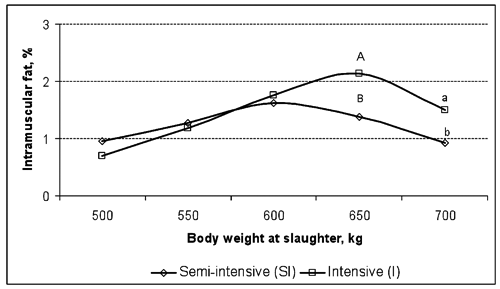
Table 1. Chemical composition and nutritional value ingredients of experimental diets (mean±SD).
Table 2. Chemical composition and nutritional value of total mixed ration.
Table 3. Average age at slaughter and selected traits of intensively and semi-intensively fattened Holstein-Friesian bulls.
Table 4. The effect of fattening intensity on fatty acid groups and ratios in intramuscular fat.
Table 5. The effect of fattening intensity on functional fatty acids in intramuscular fat.
Conclusions
Intensive fattening young Holstein-Friesian bulls, compared with the SI contributed to an increase growth rate, carcass dressing percentage, carcass conformation scores and intramuscular fat content of m. longissimus dorsi, and it did not reduce fat quality. Irrespective of the fattening intensity, the n-6/n-3 ratio was greater in heavier bulls. Greater BW at slaughter was correlated with greater external fat thickness, whereas the highest intramuscular fat content was noted at BW of 600-650 kg. The best results were achieved when bulls were I-fattened to a BW of 650 kg.
Acknowledgments
Research was realised within the project Optimising of Beef Production in Poland according to Fork-to-Farm Strategy no. PO IG 01.03.01-00-204 co-financed by the European Union from the European Regional Development Fund within the Innovative Economy Operational Programme 2007-2013.
References
- AchremowiczK. Szary-SworstK. 2005. Wielonienasycone kwasy tłuszczowe czynnikiem poprawy stanu zdrowia człowieka. Żywn.-Nauk. Technol. Ja. 44:23-35.
- BartonL. TeslikV. ZahradkovayR. BuresD. 2003. Growth, feed efficiency and carcass characteristics of Czech Pied and Holstein bulls. Czech J. Anim. Sci. 48:459-465.
- BasarabJ.A. AalhusJ.L. ShahM.A. MirP.S. BaronV.S. DuganM. OkineE.K. RobertsonW.M. 2007. Effect of feeding sunflower seeds on the performance, carcass characteristics, meat quality, retail stability and sensory characteristics of pasture-fed and feedlot finished beef. Can. J. Anim. Sci. 87:15-27.
- BerthiaumeR. MandellJ. FaucitanoL. LafreniereC. 2006. Comparison of alternative beef production systems based on forage finishing or grain-forage diets with or without growth promotants: 1. Feedlot performance, carcass quality, and production costs. J. Anim. Sci. 84:2168-2177.
- BilikK. WęglarzyK. ChoroszyZ. 2009. Effect of feeding intensity of Limousin bulls on production parameters and dietetic properties of meat. Rocz. Nauk. Zoot. 36:63-73.
- BreslowJ.L. 2006. n-3 Fatty acids and cardiovascular disease. Am. J. Clin. Nutr. 83:1477-1482.
- BrunsK.W. PritchardR.H. BoggsD.L. 2004. The relationship among body weight, body composition, and intramuscular fat content in steers. J. Anim. Sci. 82:1315-1322.
- De SmetS. WebbE.C. ClaeysE. UytterhaegenL. DemeyerD.I. 2000. Effect of dietary energy and protein levels on fatty acid composition of intramuscular fat in double-muscled Belgian Blue bulls. Meat Sci. 56:73-79.
- DeckerE.A. FaustmanC. Lopez-BoteC.J. 2000. Antioxidants in muscle foods. Nutritional strategies to improve quality. John Wiley Publ., New York, NY, USA.
- HarrisW.S. 2001. Omega 3 fatty acids and human chylomicron metabolism. World Rev. Nutr. Diet. 88:163-167.
- HollóG. CsapóJ. SzűcsE. TözsérJ. RepaI. HollóI. 2001. Influence of breed, slaughter weight and gender on chemical composition of beef. Part 2. Fatty acid composition of fat in rib samples. Asian Austral. J. Anim. 14:1719-1723.
- HuhtanenP. VanhataloA. VarvikkoT. 2002. Effect of abomasal infusions of histidine, glucose, and leucine on milk production and plasma metabolites of dairy cows fed grass silage diets. J. Dairy Sci. 85:204-216.
- HuuskonenA. KhaliliH. Joki-TokolaE. 2007. Effects of three different concentrate proportions and rapeseed meal supplement to grass silage on animal performance of dairy breed bulls with TMR feeding. Livest. Sci. 110:154-165.
- ISO, 2000. Meat and meat products. Determination of free fat content. Norm ISO 1444:2000. International Organization for Standardization Publ., Geneva, Switzerland.
- ISO, 2001. Animal and vegetable fats and oils. Preparation of methyl esters of fatty acids. Norm ISO 5509:2001. International Organization for Standardization Publ., Geneva, Switzerland.
- KienS. 2004. The classification of carcasses of adult bovine animals in EUROP. Meat and Fat Research Institute ed., Warsaw, Poland.
- KirklandR.M. KeadyT.W.J. PattersonD.C. KilpatrickD.J. SteenR.W.J. 2006. The effect of slaughter weight and sexual status on performance characteristics of male Holstein-Friesian cattle offered a cereal-based diet. Anim. Sci. 82:397-404.
- LitwińczukZ. BarłowskaJ. FlorekM. TabałaK. 2006. Slaughter value of heifers, cows and young bulls from commercial beef production in the central-eastern region of Poland. Anim. Sci. Pap. Rep. 24(Suppl.2):187-194.
- MaherS.C. MullenA.M. KeaneM.G. BuckleyD.J. KerryJ.P. MoloneyA.P. 2004. Decreasing variation in the eating quality of beef through homogenous pre-and post-slaughter management. Meat Sci. 67:33-43.
- NociF. MonahanF.J. FrenchP. MaloneyA.P. 2005. The fatty acid composition of muscle fat and subcutaneous adipose tissue of pasture-fed beef heifers; influence of the duration of grazing. J. Anim. Sci. 83:1167-1178.
- NogalskiZ. KijakZ. 2001. Fattening performance and slaughter value of the offspring of Black and White cows and Welsh Black bulls. Czech J. Anim. Sci. 46:68-73.
- NogalskiZ. WrońskiM. Sobczuk-SzulM. MocholM. PogorzelskaP. 2012. The effect of body energy reserve mobilization on the fatty acid profile of milk in high-yielding Cows. Asian Austral. J. Anim. 25:1712-1721.
- OprządekJ. DymnickiE. ReklewskiZ. 2007. Growth rates and carcass composition of young cattle of different breeds. Rocz. Nauk. PTZ 3:25-31.
- PfuhlR. BellmannO. KuhnC. TeuscherF. EnderK. WegnerJ. 2007. Beef versus dairy cattle: a comparison of feed conversion, carcass composition, and meat quality. Arch. Tierzucht 50:59-70.
- SamiA.S. AugustiniC. SchwarzF.J. 2004. Effects of feeding intensity and time on feed on performance, carcass characteristics and meat quality of Simmental bulls. Meat Sci. 67:195-201.
- SeredynK. 2006. Wartość rzeźna tusz wołowych w Polsce i ich pozycja na rynku wspólnotowym. Mięso i Wędliny 8:10-12.
- Sobczuk-SzulM. WrońskiM. Wielgosz-GrothZ. MocholM. RzemieniewskiA. NogalskiZ. Pogorzelska-PrzybyłekP. PurwinC. 2013. The effect of slaughter season on the fatty acid profile in four types of fat deposits in crossbred beef bulls. Asian Austral. J. Anim. 26:26-36.
- Statsoft Inc., 2011. STATISTICA (data analysis software system), ver. 10.0. Statsoft Inc. ed., Tulsa, OK, USA.
- WęglarzA. 2010. Quality of beef from polish Holstein-Frisian bulls as related to weight at slaughter. Ann. Anim. Sci. 10:467-476.
- WichłaczH. TrelaJ. GrześkowiakE. 1998. Wpływ poziomu tłuszczu śródmięśniowego na cechy fizykochemiczne i sensoryczne mięśnia najdłuższego grzbietu młodego bydła rzeźnego. Zeszyty Naukowe Akademii Rolniczej we Wrocławiu 336:157-163.
- ŻegarskaZ. JaworskiJ. BorejszoZ. 1991. Ocena zmodyfikowanej metody Peiskera otrzymywania estrów metylowych kwasów tłuszczowych. Acta Acad. Agric. Tech. Olst. 24:25-33.

